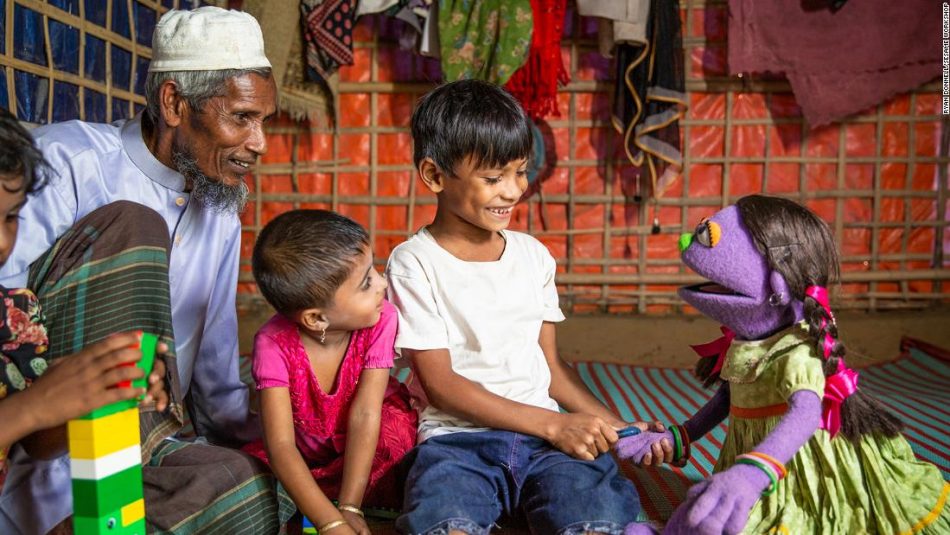A heartwarming initiative from the creators of “Sesame Street” shows that the international community is finally beginning to understand how to effectively approach the perennial issue of education for refugees. Sesame Workshop, the nonprofit that creates the early education TV show, has unveiled Aziz and Noor, two new Muppet characters who are twin brother and sister Rohingya children.
This will be the first time that Rohingya children will have seen anyone like them in a mainstream media production. What is more, the two characters will appear alongside Elmo and other beloved characters in shows in the Rohingya language that are dedicated to topics in math, science and health, among others. This is all part of a curriculum developed by Sesame Workshop, alongside a number of other high-profile charities, specifically for Rohingya children.
It is believed that the majority of the 1 million-plus Rohingya in the camps near Cox’s Bazar in Bangladesh are children, and some half a million of them will have never seen the inside of a classroom. The damage being done to them as individuals, and to the Rohingya as a group, every day that these children miss out on a proper education is immeasurable. And no one initiative like this could ever hope to fully plug the gaps. But for this kind of project to be taking place at all is genuinely wonderful, and the approach is simply genius. It is imperative that children of all ages who have been taken out of any kind of normal educational pathway are given at least a basic foundation upon which more traditional educational charities can build — and this will be a solid basis, as well as an item of culture that will bind their generation for the rest of their lives.
After the basic physical needs of shelter and food for the refugees have been met, health and education are the next most pressing requirements. There has been a scramble from the Bangladeshi authorities, and especially nongovernmental organizations and UN humanitarian agencies, to provide health facilities throughout the past year, as the specter of the coronavirus disease loomed large over this particularly vulnerable population. But education remains a glaring gap.
One of the most welcome developments on the education front last year was when Bangladesh lifted some restrictions on refugee access to the schooling system in the country, whereby children aged 11 to 13 were allowed to receive proper schooling. The restrictions had been in place for more than 30 years and were motivated by a desire to avoid the permanent integration of refugees into Bangladeshi society, so as to motivate their return to their countries of origin. But, at last, the authorities of the country recognized last year that having a “lost generation” (in their own words) on their hands would not be good for anyone — not for the refugees, of course, but also not for anyone else in Bangladesh. And, as the past few months seem to have shown an increasing recognition among the authorities in the country that the repatriation of the Rohingya to Myanmar is an increasingly distant prospect, education for the refugees will likely become an increasing focus.
But the gaps in education provision in the camps are still glaring. It is obvious, for one, that proper education provision for the children in the camps must begin much, much earlier. And it is also very much necessary that the education provision is tailored to meet the particular requirements of children who have missed so many years of formal education, and have suffered extensive trauma in their flight from Myanmar. For example, the “Sesame Street” shows are very careful about loud noises, as many of the children still remember the gunfire that accompanied the assaults on their villages and have intense traumatic responses to similar noises.
All of this requires a great deal of investment, both financial and logistical, and Bangladesh cannot and should not be expected to do this all on its own. Fortunately, there are a number of very good educational charities on the ground that are working hard to provide these children with some kind of foundation, but they are far from able to bootstrap an entire education system by themselves. This needs to be the main focus of work by the international community in the coming year: We must provide the resources necessary for the charities on the ground and the Bangladeshi authorities to build a schooling system for the refugee children that can eventually direct these children toward higher and further education within the structures of the mainstream education system of Bangladesh. If we manage to do that, we will avoid an entire lost generation, which would be disastrous for both the Rohingya and for Bangladesh more broadly.
*The writer is the Director at the Center for Global Policy and author of “The Rohingyas: Inside Myanmar’s Genocide” (Hurst, 2017).
January 12, 2021
The viewpoints expressed by the authors do not necessarily reflect the opinions, viewpoints and editorial policies of Aequitas Review.


